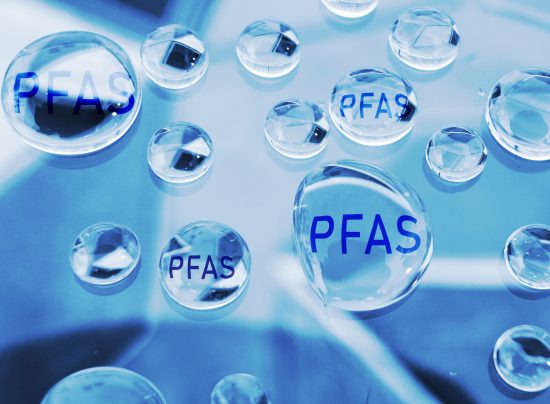Per- and polyfluoroalkyl substances (PFAS) remain a significant concern due to their persistence in the environment. The European Chemicals Agency (ECHA) and regulatory bodies continue to work towards minimising PFAS emissions through stringent restrictions.
Here’s an update on the ongoing evaluation, sector-specific considerations, and next steps in the regulatory process.

Towards stricter PFAS restrictions
The primary objective of the proposed PFAS restrictions is to minimise environmental emissions. This involves regulating the manufacture, marketing, and use of all PFAS under a group approach rather than addressing substances individually. Certain sector-specific exemptions are being considered, but only in cases where viable alternatives are unavailable.
Sector-by-sector regulatory discussions
ECHA’s committees (RAC/SEAC) are evaluating PFAS restrictions sector by sector.
Recent and upcoming discussions include:
- Already discussed: consumer mixtures, cosmetics, ski wax, metal processing, food contact materials, construction products, fluorinated gases, transport, and energy.
- June 2025: Electronics, semiconductors, lubricants, and medical devices.
Evaluation of stakeholder comments
Since the dossier’s publication in April 2024, numerous comments have been received from industry stakeholders, environmental groups, and regulatory bodies. These comments have helped shape ongoing discussions within ECHA committees.
Newly identified uses and sectors
The assessment has highlighted additional PFAS applications requiring regulatory scrutiny, including:
- Sealing materials
- Printing technology applications
- Technical textiles
- Medical applications
- Machinery components
- Spare parts and machinery
- Military applications
Restriction options (RO)
RO1: Where alternatives are available with an effective ban and to reduce emissions by 96% in 18 months.
RO2: No current alternatives available – qualification in progress
- Derogation period: 18 months + 5 years or 6.5 years
- Derogation period: 18 months + 12 years or 13.5 years
RO3: Alternative Restriction Option (initiated NOV 2024)
- continuous use of PFAS under strict conditions, to minimise emissions over the full life cycle of, e.g., fluoropolymers
Alternative approaches to restriction are being explored to address lifecycle risks comprehensively. These include:
- Mandatory take-back and recycling systems
- Enforceable manufacturing and disposal regulations
- Emission control measures (wastewater, air limits, etc.)
The FPG Manufacturing Programme
During the FPP4EU Collaboration Platform Workshop on 27th March 2025, Ronald Bock – Chair at Fluoropolymer Product Group (FPG) – presented an update on the FPG Manufacturing Programme.
Within the framework of the industry’s voluntary Manufacturing Programme, members − AGC Chemicals Europe, Ltd., Arkema, Chemours Netherlands B.V, Daikin Chemical Europe, Syensqo SA and W. L. Gore & Associates − have successfully met the first pillar of the Programme, emissions reduction target for non-polymeric PFAS residues from polymerisation aid technology in air and water. Specifically, members of the Programme have:
- For Air, achieved a reduction of these emissions in their 2024 annual average emission factors below their target of 0.009%.
- For Water, while not all European fluoropolymer manufacturers have met the 2024 annual average emission factor for the emissions target of 0.001%, they all met that ambitious target at the end of 2024, therefore guaranteeing these emissions below 0.001% for 2025.
The programme comprises two other pillars, more specifically:
- a platform to exchange information on commercially available state-of-the-art technologies to minimise non-polymeric PFAS emissions in manufacturing; and,
- a commitment to inform downstream users of fluoropolymers on their safe handling and use in the Guide for the Safe Handling of Fluoropolymer Resins.
This is in line with the Manufacturing Programme for European manufacturing sites agreed upon by the above-mentioned European fluoropolymers manufacturers in September 2023.
The programme’s success demonstrates that European fluoropolymer manufacturers are leading the way in sustainable production, ensuring that these critical materials continue to support strategic technologies while protecting the environment.
Next steps & stakeholder involvement
As part of the decision-making process, the European Commission and REACH regulatory committee will conduct a 60-day consultation period following the draft SEAC opinion. Companies and industry stakeholders should prepare by:
- participating in RAC/SEAC meetings where possible;
- reviewing prior SEAC consultations and restriction registers, if permitted;
- submitting targeted data on tonnage, emissions, alternative solutions, and substitution challenges.
France takes bold action on PFAS: a step toward a cleaner future

On February 20, the French Parliament passed groundbreaking legislation aimed at significantly reducing PFAS (Per- and Polyfluoroalkyl Substances), marking a decisive step forward in environmental and public health protection.
Often dubbed “forever chemicals” due to their extreme persistence in the environment, PFAS have been linked to serious health risks and ecological harm. France’s new law directly targets these hazardous substances with a phased ban and strengthened monitoring efforts.
Key measures of the new law
2026 – PFAS will be banned in cosmetics, textiles, ski wax, and footwear.
2030 – The ban will extend to all textile products, with exceptions only for protective clothing used by emergency services and military forces.
Mandatory monitoring of PFAS in drinking water will be implemented.
Introduction of the “polluter pays” principle, ensuring fines for companies found responsible for PFAS pollution.
By following Denmark’s lead, France is setting a high benchmark for environmental regulation across the EU. These measures not only protect the French population but could also serve as a catalyst for unitary EU-wide regulations on PFAS.
Update from the USA: EPA finalises PFAS reporting rules under TSCA

In a significant move toward environmental accountability, the U.S. Environmental Protection Agency (EPA) has finalised its reporting and recordkeeping requirements for per- and polyfluoroalkyl substances (PFAS) under the Toxic Substances Control Act (TSCA). These new rules mark a key step in addressing the risks posed by these persistent chemicals, often referred to as “forever chemicals”.
Under the finalised rule, any person or entity that has manufactured or imported PFAS or PFAS-containing articles since January 1, 2011, is now required to electronically report detailed information regarding:
- PFAS uses
- Production volumes
- Disposal practices
- Exposures
- Associated hazards
This rule applies retroactively, ensuring a broad capture of PFAS-related activity over the last decade-plus.
However, implementation of the new reporting requirement under TSCA Section 8(a)(7) has faced delays due to limited agency resources. The EPA has confirmed that the reporting database is not yet ready.
As a result, the launch of the reporting portal has been postponed. The new timeline anticipates the portal will open in July 2025 and close in January 2026. This extension offers manufacturers and importers additional time to prepare and gather the necessary data for submission.
Stakeholders are encouraged to stay informed and begin compiling relevant records to ensure timely compliance once the portal becomes active.
Government of Canada releases landmark report on PFAS: new regulatory measures proposed

On March 5, the Government of Canada published the State of Per- and Polyfluoroalkyl Substances (PFAS) Report, marking a significant milestone in the country’s efforts to address chemical substances that pose risks to human health and the environment.
The report concludes that the class of PFAS – excluding fluoropolymers – poses potential harm to both people and ecosystems. Fluoropolymers, a subgroup within PFAS, will not be included in this assessment and will be considered separately at a later date.
In response to the findings, the Government is proposing to list PFAS (excluding fluoropolymers) as a class under Part 2 of Schedule 1 to the Canadian Environmental Protection Act, 1999 (CEPA). This designation would formally recognise these substances as toxic and enable regulatory actions to reduce exposure.
Two-phase regulatory approach
To manage the risks associated with PFAS, the Government is rolling out a two-phase plan:
- Phase 1 – Starting in 2025, the initial focus will be on reducing and eventually eliminating the use of PFAS in firefighting foams, a major source of environmental contamination.
- Phase 2 – This phase will target non-essential uses of PFAS in consumer products that do not contribute to health, safety, or environmental protection. This includes items such as cosmetics, food packaging, and textiles.
These measures are part of a broader effort to protect Canadians and the environment from harmful chemical substances. Stakeholder engagement and public consultation will play a key role in shaping the next steps.
Conclusion
The regulatory landscape for PFAS is evolving rapidly, with a clear focus on emission reduction and responsible lifecycle management. Industries using PFAS should proactively engage with the consultation process and explore alternative solutions. The final regulatory decisions will be based on scientific risk assessments, sector-specific considerations, and ongoing stakeholder feedback.
Stay tuned as we monitor how these developments unfold across Europe and beyond.
Sandy Van den Broeck,
ESG Director, ESA
